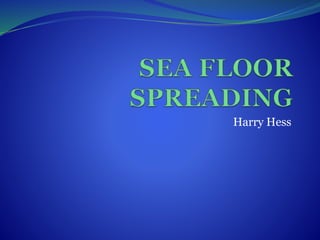
Sea Floor spreading
- 1. Harry Hess
- 2. Recall: Scientists know Earth’s interior is made mostly of layers of _______________. Some layers, like the center part, called the ______are hard and______. Other layers are not. The layer next to the center, called the_________, is _______. Both parts of the core are made of___________. inner core; liquid ; rock iron and nickel; outer core; solid
- 3. Recall: The largest layer inside Earth is called the _____. It’s neither completely solid nor completely liquid, but_____. It’s extremely______. Earth’s outermost layer is the______ . This layer is about 5 km thick under the_______ and up to 35 km thick under the______. On top of the outer layer is the weathered rock called______. continents ; mantle; plastic like crust; oceans; soil; hot
- 4. Despite the evidences presented by Wegener, WHY was his idea that the continents were once joined together was not accepted by the scientific society? This made scientists conduct further studies in search for the answer.
- 5. 1950s and 1960s- new techniques and modern gadgets sonars and submersibles scientists had a clearer view of the ocean floors discovered underwater features deep within the ocean
- 6. a system of ridges or mountains in the seafloor similar to those found in the continents (mid-ocean ridges) Mid-Atlantic Ridge: an undersea mountain chain in the Atlantic Ocean a gigantic cleft about 32-48 km long and 1.6 km deep
- 8. Activity 5: Split and Separate! Simulate and describe the seafloor spreading process. • Realize the importance of the seafloor spreading process relative to the Continental Drift Theory.
- 9. Paper Folder
- 11. Answer: Q22-27
- 13. Harry Hess
- 15. Magnetometer
- 18. Sea Floor Spreading early 1960’s- Harry Hess, together with Robert Dietz Seafloor Spreading Theory hot, less dense material from below the earth’s crust rises towards the surface at the mid-ocean ridge material flows sideways carrying the seafloor away from the ridge, and creates a crack in the crust magma flows out of the crack, cools down and becomes the new seafloor
- 21. Sea Floor Spreading allowed the creation of new bodies of water the Red Sea -African plate and the Arabian plate diverged pulling Australia, South America, and Antarctica away from each other in the East Pacific Rise The East Pacific Rise -the most active sites of seafloor spreading, more than 14 cm/yr
- 22. SFS rate of formation of a new seafloor is not always as fast as the destruction of the old seafloor at the subduction zone explains why the Pacific Ocean is getting smaller and why the Atlantic Ocean is getting wider If subduction is faster than seafloor spreading, the ocean shrinks When the seafloor spreading is greater than the subduction, then the ocean gets wider
- 24. The SFS contradicts a part of the CDT CDT- continents moved through unmoving oceans and that larger, sturdier continents broke through the oceanic crust Whereas, the seafloor spreading shows that the ocean is the actual site of tectonic activity
- 25. Findings that support Seafloor Spreading Theory: Rocks are younger at the mid-ocean ridge. Rocks far from the mid-ocean ridge are older. Sediments are thinner at the ridge. Rocks at the ocean floor are younger than those at the continents.
- 26. Bring the ff: Pencil Ruler
- 27. Activity 6: How fast does it go! Objectives: • Analyze a magnetic polarity map. • Use legends and scales of the map properly. • Calculate the rate of seafloor spreading using magnetic clues.
- 28. VISIT, EXPLORE, ANSWER http://www.montereyinstitute.org/noaa/lesson02/l 2la1.htm http://earthguide.ucsd.edu/eoc/teachers/t_tectonic s/p_seafloorspreading.html
- 29. Answer: Q28-29
- 30. Magnetic Reversal magnetic ‘flip’ of the Earth the North Pole is transformed into a South Pole and the South Pole becomes the North Pole due to the change in the direction of flow in the outer core
- 31. Magnetic Reversal explained through the magnetic patterns in magnetic rocks, especially those found in the ocean floor When lava solidifies, iron bearing minerals crystallize the minerals behave like tiny compasses and align with the Earth’s magnetic field so when magnetic reversal occurs, there is also a change in the polarity of the rocks
- 32. Describe and explain each diagram/illustration.
- 40. Age of Oceanic Crust
- 42. Over the last 10 million years, there has been an average of 4 to 5 reversals per million years. New rocks are added to the ocean floor at the ridge with approximately equal amounts on both sides of the oceanic ridge. The stripes on both sides are of equal size and polarity which seemed to be mirror images across the ocean ridge.
- 43. What does this indicate? It indicates that indeed, the seafloor is spreading.
- 44. NET RESULTS Spreading rates at transform faults Pacific plate moves NW at 8 cm/yr N American plate moves W at 2 cm/yr Indian plate moves NE at 12 cm/yr Pacific Ocean is shrinking and Atlantic is growing Atlantic opened about 200 MY ago so there should be no rocks older than this in the Atlantic
- 45. Most recent episode of Seafloor spreading: Pangaea first broke into 2 pieces Sea opens between N and S continents and Between Africa and Antarctica India moves North
- 46. S Atlantic opens Antarctica moving S India moving N Australia separates and moves N
- 47. 50 MY in the future: 1. Africa will move N and close Mediterranean Sea 2. E Africa will detach (Red Sea rift zone) and move to India 3. Atlantic Ocean will grow and Pacific will shrink as it is swallowed into Aleutian trench. 4. W California will travel NW with the Pacific Plate (LA will be swallowed into the Aleutian trench in 60 MY).
- 48. Bring the ff: (by group) dropper food color 3-5 small / light wood blocks (or sponge cut into thin and small blocks)
